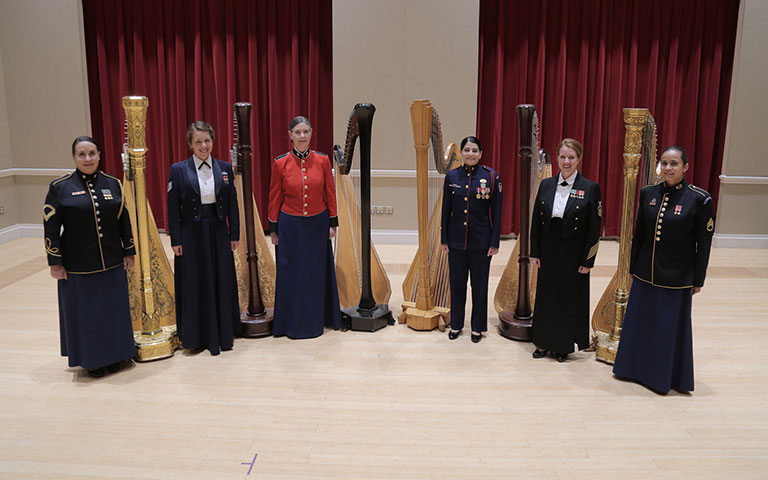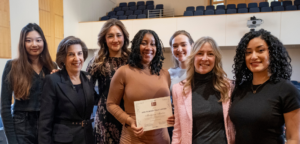With the conclusion of the American Harp Society National Competition, the AHS Summer Institute has commenced in Winston–Salem, N.C. One of the first concerts of the conference features the Armed Forces Harp Sextet performing alongside Marcela Mendez, Maria Luisa Rayan, Debra Reuter–Pivetta, and Jacquelyn Bartlett. After learning that this will be the first time in history all harpists from U.S. service bands will perform together, we reached out to the U.S. Air Force harpist, Technical Sergeant Gréta Ásgeirsson, to find out more.
How did this ensemble come to be?
Since I’ve come to DC, all of the armed services premier band harpists would casually say how great it would be to get together and get to know each other a little better. However, it’s difficult to plan anything when all of us are torn in so many directions all the time, and Coast Guard harpist, Chief Musician (MUC) Megan Sesma is stationed in Connecticut! Thankfully, Army Band harpist, Sergeant First Class (SFC) Nadia Pessoa took the lead when she contacted all of us last summer and asked us if we’d be interested in putting together an ensemble to play at the Summer Institute. All of us were very much interested, and thus started the Joint Service Harp Ensemble!
I know the logistics of getting harpists together to make music can be pretty difficult. What has it been like getting six professional harpists together to rehearse?
Each of us has a unique schedule based around each service band’s mission. And then on top of that, there might be a last–minute dinner or reception that needs to be played, or a presidential state funeral! MUC Sesma has been incredibly accommodating and has been able to travel to DC so that we can all rehearse.
Remarkably, our harp logistics have been fairly simple! We aren’t able to rehearse with any great frequency due to geographical limitations. However, when we do meet up, Marine Band harpist, Master Gunnery Sergeant (MGySgt) Karen Grimsey has been so accommodating as to host our ensemble at the Marine Band’s rehearsal studios and allow us to use the band’s harps!

From left: Nadia Pessoa, Pershing’s Own U.S. Army Band; Gréta Ásgeirsson, U.S. Air Force Band; Karen Grimsey, The President’s Own U.S. Marine Band; Megan Sesma, U.S. Coast Guard Band; Emily Dickson, U.S. Navy Band; Grace Bauson, U.S. Army Field Band
I know your concert is called “History in Harmony.” Who decided the program? Any pieces you’re particularly excited to play?
We started brainstorming our programing last summer and it was a joint effort. Because of the nature of our positions, we thought that it was only appropriate that we program the Star–Spangled Banner and America the Beautiful. From there, we wanted to choose an arranger that we all liked and trusted to arrange it for us. MUC Sesma had already commissioned Daniel Burton to arrange America the Beautiful and the national anthem for flute, harp, and soprano, so she asked if he could rearrange it for harp sextet! For our non–patriotic selection, we wanted to feature a piece that showed off our versatility and wanted to stick with another arranger that we trusted. I went to Boston University with Michael Maganuco and loved everything that he had composed and arranged. He already had a phenomenal arrangement of the second movement of the Ravel String Quartet, so I asked him if he would be interested in adding parts for us, and thankfully he was! It’s been a joy putting the Ravel together with the other service harpists, but it’s also been a pleasure to play our patriotic selections with each other. Both patriotic pieces are played on every single concert that we all play, and to collaborate with my fellow service women on our shared mission has been wonderful.
I know that we’re all thrilled to have the opportunity to open the History in Harmony concert with our performance. Part of my job in the Air Force Band is to connect with people and inspire them to be patriotic, and we will do that by presenting the national anthem and America the Beautiful. We’re also able to showcase the diverse artistic breadth of our positions through our performance of the Ravel.
Any repeat performances in the works for those of us who can’t be at your June 19th concert?
Now that we have the ball rolling, we do plan on performing together more regularly as we’re able! At this point, we hope to schedule some concerts in the Washington D.C area.
You won your job almost three years ago. What can you share about the adjustment to military life? Any surprises?
I think the answer that most people expect to hear on military life is in regards to basic military training. While basic training was certainly a unique experience, it was an enlightening one. It was humbling to go through a foreign process with strangers and come out the other end with an understanding that any unknown task can be achieved. Ultimately, it ends up being a common bond that everyone in the Air Force has. I think perhaps the most surprising aspect of my job has been that the Air Force Band not only operates as the performers but also as its own management. Each member has another responsibility on top of performing to ensure that the organization operates efficiently in order to fulfill our mission. Band members set up our tours, do our own marketing, organize educational outreach, and balance the budget. For instance, my job is working in the music library coordinating repertoire for members of the concert band. While this dual responsibility was a surprise at first, I think the expertise that we cultivate as performers and support staff is what makes us unique.
That’s really interesting—I had no idea! Any fun stories or experiences from the past three years that you can share with us?
Touring is one of my favorite aspects of the job. We tour twice a year to various areas of the country. We’ve been to remote towns and major cities, and seen the way that our work touches individuals and communities alike. Some of my favorite venues on tour have been gymnasiums where the divide between the audience and the stage is blurred, so many audience members want to come up to talk and try our instruments!
Another great aspect of this job is collaborating with colleagues through chamber music. As a result of our different ensembles, I’ve been fortunate to play Maurice Ravel’s Introduction et Allegro, as well as Makoto Ozone’s Times Like These for Harp and Vibraphone, and Yasuhide Ito’s Four Euphoniums for You (for euphonium quartet and harp!).
We love to honor our military veterans, and another highlight of my career was playing at a reception where a Tuskegee Airman sang along as I performed Somewhere Over the Rainbow. Using music to connect with and honor such a historic veteran was something I will never forget.
Anything else you’d like to add?
My role as a harpist and military member is the result of long years of study and has been a fun and interesting path to take. While military bands may not be your normal ensemble experience as a harpist (as there are only six of us in the country), it is a pleasure and privilege to serve my country, my craft, and the United States Air Force as a military musician.












